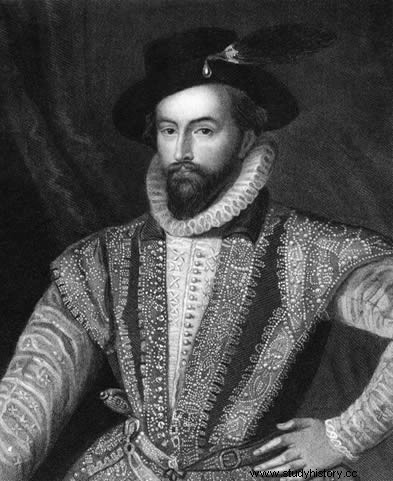
By Fabrício Santos
The 15th century marked the development of sea navigation, which was used for the economic expansion of European countries. Portugal and Spain were the pioneers to venture across the oceans in search of land and precious metals, which culminated in the colonization of several regions located in America. With the success of maritime expeditions, other countries also ventured into the search for colonies that would provide profitable trade relations, as was the case with England.
At the end of the 16th century, the English, with the ambition of conquering new lands, invested in shipbuilding and in mercantile policy to accumulate wealth for the kingdom. For this they founded trading companies that united king and bourgeoisie to finance maritime expeditions and find regions that could be colonized.
The first attempts took place between 1584 and 1587, when an expedition commanded by sir Walter Raleigh tried to conquer the territory of North America, but this expedition was violently defeated by the natives who resisted the English conquest. However, in 1607, a trading company managed to subdue the natives and founded the colony of Virginia, which was the first region dominated by the British.
In the colony of Virginia, the British invested in the production of tobacco, which was a highly profitable product in the European market. In the course of exploration, other regions were conquered for investments in the production of agricultural products, such as the colonies of Georgia, North and South Carolina, Maryland and Delaware.
The colonies that emerged developed different characteristics both in terms of economy and population. In regions located to the South, a exploitation colonization developed. The settlers aimed at profits in the commercialization of agricultural products that were sold in Europe. This type of colonization was similar to that of the Portuguese colonies, which were used for the purpose of providing wealth to the colonizers through, for example, the practice of slave labor.
In regions to the North, the colonies of New Jersey , New York and Massachusetts , for example, developed a type of colonization called settlement . The intention of the settlers of this region was not simply to explore, but to make it a new place to live. Therefore, there was no direct participation of the English crown in the Northern colonies, since this region, due to its less favorable climate for agriculture, did not attract the attention of traders eager for profits.
The settlement of the Northern colonies was also different, as the settlers of this region were largely religious refugees. The Catholic Church's persecution of Protestants culminated in the coming of many people to these colonies, as there was the possibility of a new world with religious tolerance. In 1620, a group of Puritans founded Plymouth, who helped to populate this region.
English colonization differed in many ways from colonization in Portuguese America. While in the British colonies of the South, for example, a population was developed with the objective of generating economic development aimed at the internal market, the Portuguese colony developed a mercantile practice with the ambition of exploiting the riches to be traded in the external market. Thus, the British colonies in the South gained more political and economic autonomy from their homeland, while the Portuguese colony in America became increasingly economically dependent on its conquering country.
Take the opportunity to check out our video lesson related to the subject:
